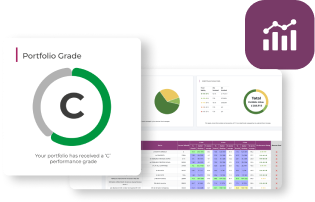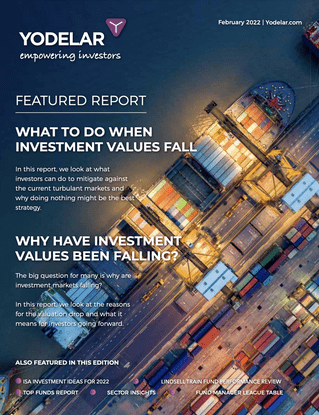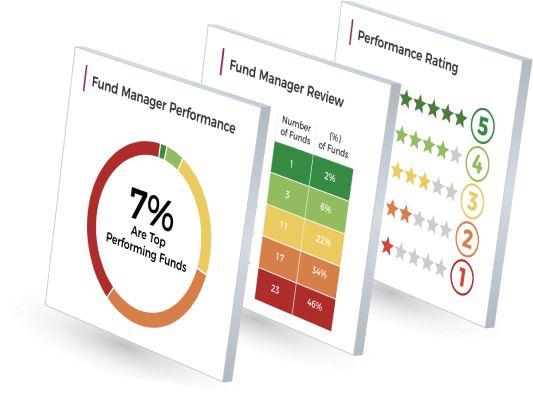- Diversification is vital to portfolio success, but when applied poorly, it can create hidden risks, duplication, and inefficiencies that undermine performance.
- Overexposure to dominant markets, particularly North America, has left thousands of UK investors vulnerable to sharp declines and increased portfolio volatility.
- Inefficient diversification often leads to overreaction prompting investors and advisers to make unnecessary, short-term changes that disrupt long-term strategy.
- Truly efficient portfolios are constructed with purpose using a carefully selected blend of funds that serve distinct roles and work cohesively to manage risk and drive returns.
- Maintaining diversification requires expert oversight, regular review, and a disciplined approach grounded in fund performance and structured asset allocation.
Diversification is one of the most widely promoted principles in investing - but when misunderstood or poorly applied, it can do more harm than good.
Many investors believe that spreading their money across multiple funds, sectors, or regions automatically delivers safety and balance. But true diversification is not just about how many investments you hold - it’s about how they work together. Overlapping strategies, overexposure to a single market, or failure to understand how individual funds behave can quietly erode efficiency and increase risk, even in portfolios that appear well-constructed on the surface.
In this article, we explore the fine balance between meaningful diversification and over-diversification. We examine how duplication, style bias, and reactive decision-making can disrupt portfolio efficiency, and explain how to avoid these pitfalls through smart construction, purposeful fund selection, and disciplined strategy.
For investors looking to optimise performance while managing risk effectively, understanding the difference is critical.
The Foundation of Portfolio Efficiency: Diversification and Asset Allocation
Diversification and asset allocation are often described as the bedrock of successful long-term investing. They play a central role in managing risk and improving the consistency of returns - regardless of short-term market conditions.
Diversification is the process of spreading investments across a range of different assets. The aim is to reduce the impact of any single holding, region, or sector performing poorly. By avoiding concentration in one area, a diversified portfolio is better positioned to absorb shocks and take advantage of different parts of the market as they rise at different times.
Asset allocation takes this principle further. It involves deciding how much of a portfolio should be allocated to various asset classes - such as equities and bonds - and how these allocations are spread across geographies like the UK, North America, Europe, or emerging markets. The right allocation depends on an investor’s goals, risk tolerance, and time horizon, but the principle remains the same: balance is key.
Research consistently shows that asset allocation - not stock picking or market timing - is the primary driver of long-term portfolio returns. But while diversification and asset allocation are powerful tools, they are only effective when applied with structure and intention.
Too often, investors believe that simply holding multiple funds or investing across a few different regions is enough. But without understanding what’s inside those funds, and how they work together, portfolios can end up less diversified than they appear. What looks like a balanced portfolio may in fact carry unnecessary overlap, concentrated risk, or gaps in exposure.
This is why professional portfolio construction goes beyond simply deciding how much to invest in each area. It extends into how those allocations are implemented - through the careful selection and combination of individual funds. And it’s here that the next layer of diversification becomes critical.
Why Diversification Matters Across Market Cycles
A consistent theme across long-term market data is that leadership among asset classes changes frequently. One year’s top performer can easily fall to the bottom the next, and rarely does any single region, sector, or investment style maintain dominance over extended periods.

This variability makes it extremely difficult - even for professionals - to predict which areas of the market will outperform in the years ahead. As a result, portfolios that lean too heavily on recent winners risk becoming unbalanced, with performance that is overly dependent on short-term market conditions.
It’s this unpredictability that makes structured diversification so essential. Rather than chasing trends or concentrating on what has recently performed well, efficient portfolios are designed to remain balanced across multiple market areas. This provides a more consistent return profile over time and helps reduce the risk of large losses when leadership inevitably shifts.
A well-diversified portfolio ensures that no single holding or market dominates, allowing investors to benefit from a range of opportunities while maintaining the discipline needed to meet long-term objectives.
Looking Beyond Asset Allocation: The Role of Fund Selection in Achieving True Diversification
Asset allocation defines the overall shape of a portfolio - how much is invested in each region or asset class. But achieving genuine diversification goes further. It depends not just on where capital is allocated, but how it is invested within those areas. That’s where fund selection plays a critical role.
At first glance, using multiple funds to represent a specific allocation - such as North American equities - may appear sufficient. But a closer look often reveals that many of these funds share the same underlying holdings and follow similar strategies. As a result, they tend to move in tandem, limiting the effectiveness of diversification and exposing the portfolio to unnecessary duplication.
True diversification at the fund level comes from understanding how each fund behaves. High quality investment managers don’t just select top-performing funds in isolation. They construct a balanced combination - selecting a mix of funds with different investment styles, approaches, and characteristics that together offer complementary benefits. In this structure, each fund is chosen for the role it plays within the broader team - whether that’s to provide long-term growth, defensive stability, or exposure to smaller, faster-growing companies.
This method avoids overlap, enhances diversification, and ensures that each allocation works harder within the portfolio. Rather than relying on headline performance, experienced portfolio managers analyse the underlying structure of each fund - its style, its size focus, and how it performs in different market environments. The goal is to ensure that the portfolio functions as a cohesive whole, not simply a collection of individually strong components.
By taking this extra step, investors can avoid the hidden risks of duplication and unlock the full potential of their asset allocation strategy.
When Trends Drive Imbalance: The Hidden Cost of Overexposure and Underexposure
As we've outlined, true diversification requires more than holding a wide spread of funds. It depends on how those funds behave, how they complement each other, and how well the portfolio maintains its strategic balance over time.
But even portfolios that appear diversified can become structurally imbalanced when short-term market trends influence allocation decisions. A common example of this is overexposure - when investors increase exposure to a region or sector that has recently performed well, often at the expense of broader diversification.
Our portfolio analysis has consistently shown that many UK investors are heavily overweight in North American equities. This isn’t surprising. Over the past decade, the U.S. has been a dominant engine of global growth, driven by a tech-led surge from firms like Apple, Amazon, and Microsoft. As these companies delivered strong returns, investor appetite for North American exposure grew - and many advisers and portfolio models responded by increasing allocations accordingly.
But this growing reliance on a single region creates hidden risk. When markets move in their favour, these portfolios can appear to outperform, masking underlying structural weaknesses. Yet when conditions shift - such as during recent periods of volatility driven by tariff uncertainty and geopolitical tension - these same portfolios can experience outsized losses. Because so many of the underlying funds are aligned to the same market drivers, they fall together, exposing the investor to concentrated downside risk.
Equally, this focus on what’s currently performing well often comes at the cost of what isn’t. Underexposure - the neglect of out-of-favour but strategically important regions or sectors - limits diversification and can cause investors to miss out on future recoveries. Portfolios that are underweight or exclude entire asset classes based on short-term sentiment risk becoming unbalanced, undermining their ability to deliver consistent, risk-adjusted growth over time.
These allocation imbalances are often reactionary. As mentioned, duplication and style bias can lead to large portfolio swings, which then prompt further adjustments that amplify the problem. Investors chase past performance, reduce exposure to areas that feel uncertain, and end up with portfolios that are highly reactive - but poorly diversified.
This is why efficient, forward-looking diversification matters. Markets are cyclical. No single sector or region leads forever. And while it’s tempting to lean into what’s working now, the most resilient portfolios are those that maintain balance, discipline, and strategic allocation - even when it feels counterintuitive to do so.
When Poor Diversification Leads to Overreaction
One of the less visible but more damaging outcomes of poor diversification is its effect on investor behaviour. Portfolios that appear diversified but contain overlapping funds and duplicated strategies are more prone to sharp swings in performance - both positive and negative. These swings often prompt unnecessary and reactionary changes to portfolio structure.
When markets favour a specific investment style - such as growth-focused large-cap equities - portfolios that unknowingly hold several funds following similar strategies tend to perform well. This short-term outperformance can mask the inefficiencies caused by duplication. As those funds rise together, their combined weight within the portfolio can grow disproportionately, increasing concentration and distorting the intended asset mix.
However, when markets shift and no longer support that style, the downside can be amplified. Since many of the funds behave similarly, they fall together - exposing the portfolio to sharper declines and creating the impression that the portfolio is less diversified than it appeared. This can prompt investors and advisers to overreact, adjusting asset allocation or adding new holdings in an attempt to correct the imbalance. In many cases, this leads to over-diversification, excessive trading, or short-term decisions that do more harm than good.
While periodic rebalancing is a healthy and necessary part of maintaining a portfolio, duplication often exaggerates its need. Portfolios that hold too many funds with similar characteristics require more frequent adjustments as their internal balance is easily disrupted by market movements.
Ultimately, a portfolio that lacks genuine diversification is more volatile beneath the surface - driving a cycle of overreaction, inefficient change, and further complexity. Avoiding this cycle starts with smarter construction: selecting funds that behave differently, contribute distinct strengths, and work together as a cohesive unit.
Strategic and Diversified Investing for Long-Term Success
Investing successfully is rarely about reacting to short-term trends. It’s about having a clear plan, maintaining discipline, and building a portfolio that is structured for resilience and long-term growth.
As this article highlights, many investors unknowingly fall into patterns of inefficiency - whether through duplication, overreaction, or lack of proper diversification. But these risks can be avoided with the right guidance and structure.
By taking a strategic approach, avoiding common pitfalls, and maintaining a well-diversified portfolio, investors can significantly improve their chances of achieving long-term success.
If you’d like to better understand how your portfolio measures up - or explore ways to improve its efficiency - book a no-obligation call with one of our regulated advisers.
Diversification Through Time: The Importance of Consistency
Diversification is not a one-off exercise. Markets evolve, correlations shift, and fund strategies adapt. A portfolio that was well-balanced two years ago can quietly drift out of alignment - even if no new contributions or withdrawals have been made.
Without regular oversight, portfolios can become structurally skewed. Asset weightings change as markets move, and what once provided balance may now result in concentration. Diversification, if not actively maintained, can erode over time and expose the portfolio to unintended risks.
This is why consistency matters. Efficient portfolios are not just diversified at a point in time - they remain diversified. That requires a structured process of ongoing monitoring, periodic rebalancing, and the discipline to make adjustments only when they align with long-term strategy - not in response to short-term noise.
Partnering with an advice firm that understands the mechanics of fund performance, portfolio allocation, and risk-modelling is crucial to maintaining this consistency. High-quality advisers assess not just where money is invested, but how each component of a portfolio behaves over time and how the overall structure needs to evolve with market conditions.
By combining analytical insight with disciplined review, investors can ensure that their portfolios stay aligned with their objectives - delivering consistent, risk-managed growth throughout all stages of the market cycle.
Conclusion
The principles of diversification and asset allocation are well-established - but as this article has shown, applying them correctly is what separates efficient portfolios from inefficient ones.
Overexposure into popular sectors, underexposure to neglected regions, reacting to short-term market moves, and failing to assess the structure of underlying funds are all mistakes that can quietly compromise long-term performance. These issues aren’t always visible - but they can significantly alter outcomes over time.
Efficient portfolio construction requires more than good intentions. It demands structure, clarity, and expertise - ensuring each component plays a defined role and contributes to a broader, goal-focused strategy.
For investors who want to protect and grow their wealth consistently, this is not something to leave to chance.
If you’d like to better understand how your portfolio measures up - or explore ways to improve its efficiency - book a no-obligation call with one of our regulated advisers. We’ll help you make sure your investments are working as hard as they should be.


















